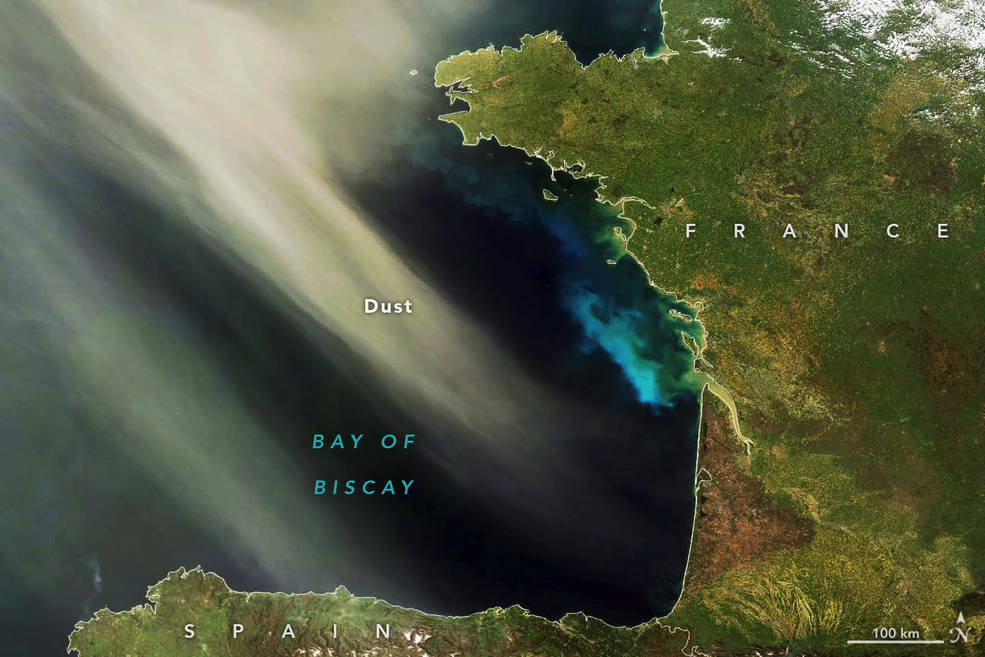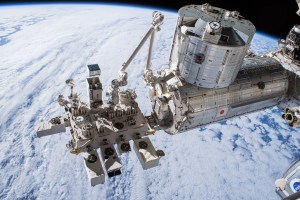After a long-distance delivery, nutrients in desert dust nourish life in the ocean.
For the past few decades, scientists have been observing natural ocean fertilization events — episodes when plumes of volcanic ash, glacial flour, wildfire soot, and desert dust blow out onto the sea surface and spur massive blooms of phytoplankton. But beyond these extreme events, there is a steady, long-distance rain of dust particles onto the ocean that promotes phytoplankton growth just about all year and in nearly every basin.
In a new study published May 5 in the journal Science, a team of researchers from Oregon State University, the University of Maryland Baltimore County, and NASA combined satellite observations with an advanced computer model to home in on how mineral dust from land fertilizes the growth of phytoplankton in the ocean. Phytoplankton are microscopic, plant-like organisms that form the center of the marine food web.

Phytoplankton float near the ocean surface primarily subsisting on sunlight and mineral nutrients that well up from the depths or float out to sea in coastal runoff. But mineral-rich desert dust — borne by strong winds and deposited in the ocean — also plays an important role in the health and abundance of phytoplankton.
According to the new study, dust deposition onto the ocean supports about 4.5% of yearly global export production — a measure of how much of the carbon phytoplankton take up during photosynthesis sinks into the deep ocean. However, this contribution approaches 20% to 40% in some ocean regions at middle and higher latitudes.
Phytoplankton play a large role in Earth’s climate and carbon cycle. Like land plants, they contain chlorophyll and derive energy from sunlight through photosynthesis. They produce oxygen and sequester a tremendous amount of carbon dioxide in the process, potentially on a scale comparable to rainforests. And they are at the bottom of an ocean-wide food pecking order that ranges from tiny zooplankton to fish to whales.
Dust particles can travel thousands of miles before falling into the ocean, where they nourish phytoplankton long distances from the dust source, said study coauthor Lorraine Remer, a research professor at the University of Maryland, Baltimore County. “We knew that atmospheric transport of desert dust is part of what makes the ocean ‘click,’ but we didn’t know how to find it,” she said.
Ocean Color Tells a Tale
How do you track ocean biology from 400 miles above the surface of Earth? Follow the green trail of chlorophyll.
Study authors Toby Westberry and Michael Behrenfeld — remote sensing oceanographers at Oregon State University — analyzed 14 years of ocean color measurements collected by the Moderate Resolution Imaging Spectroradiometer (MODIS) on NASA’s Aqua satellite from 2003 through 2016. Tracing distinct signatures in ocean color, they were able to determine not only when and where phytoplankton blooms occurred, but also how healthy and abundant they were (based on the concentration of chlorophyll).
To determine if the phytoplankton were responding to desert dust, the team compared their ocean color findings with output from NASA’s Goddard Earth Observing System (GEOS) model of dust deposition events for the same time period. These events ranged in intensity from mighty Saharan dust storms to relatively subdued plumes off the U.S. West Coast. They found that even modest amounts of desert dust increased the mass and improved the health of phytoplankton blooms almost everywhere they looked.
Previous studies had focused on large local events — volcanic eruptions, wildfires, extreme dust storms — that spewed huge amounts of organic and mineral particles into the air. In other studies, researchers intentionally stimulated phytoplankton growth by ‘seeding’ seawater with iron, a key but often limited nutrient in the ocean.
“We observed that the phytoplankton response wasn’t just happening in iron-poor areas of the ocean,” said coauthor Hongbin Yu, a scientist at NASA’s Goddard Space Flight Center. “The responses were occurring all over the world. Add a little bit of nutrients and you’ve got something happening in the water.”
The nutritional benefits of desert dust aren’t limited to iron, the scientists said. Dust particles contain other nutrients that plants need, notably phosphorus and nitrogen.
More research is needed as climate change impacts atmospheric patterns, soil moisture, and other factors that influence how dust journeys to the ocean, Remer said.
“For me,” she added, “the most interesting piece of what we accomplished here was bringing oceanographers and atmospheric scientists to the same table.”
Sally Younger
Earth Science News Team
NASA’s Jet Propulsion Laboratory, Pasadena, Calif.
sally.m.younger@jpl.nasa.gov
Michael Carlowicz,
Headquarters, Washington
michael.j.carlowicz@nasa.gov


























